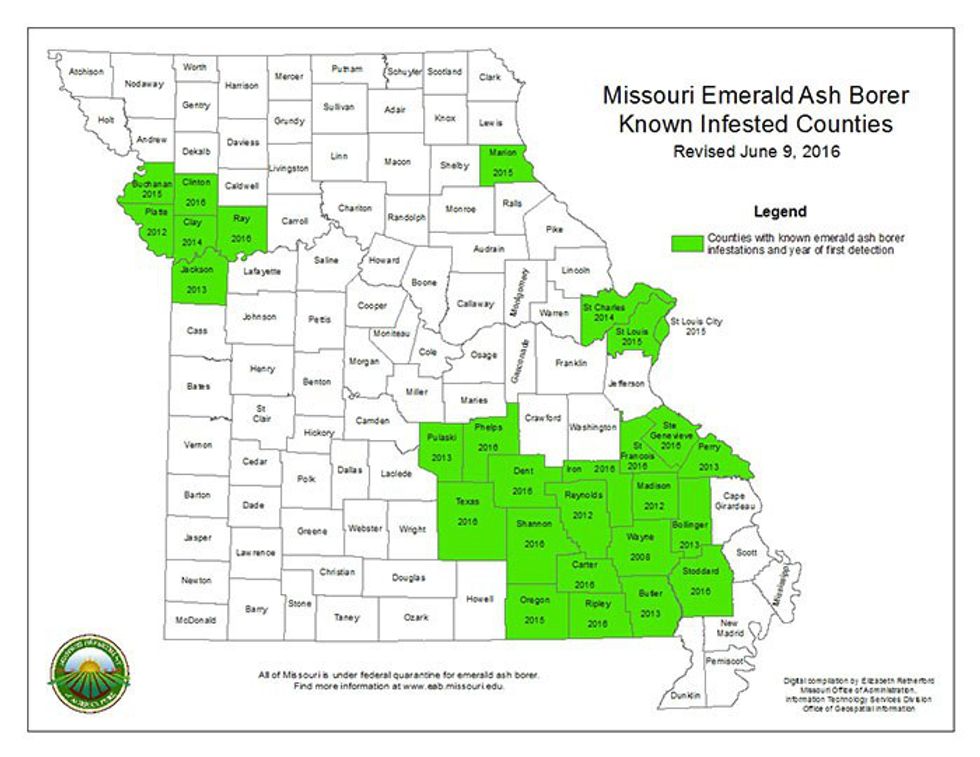The spookiest thing this Halloween is the Emerald Ash Borer. Spreading faster than any zombie plague, this “epidemic” has reached as many as 27 states across the country as estimated by the US Department of Agriculture. Missouri in particular has recently mobilized its Forestry Division for war against the bugs in which "tens of millions of ash trees” have already been lost.
The beetle is believed to have been accidentally brought from Asia. The bug preys on the flesh of innocent ash trees, burrowing deep inside, “disrupting the tree's ability to transport water and nutrients, eventually killing the tree”. This is particularly a problem due to ash trees being common in its usage from the city to the suburbs.
These are MO’s infested counties provided by the Missouri Department of Agriculture:
"This is horrible", you must be thinking, "how do we stop the spread of such a persistent bug?" Answer—"Don’t Move the Firewood!" This video should explain.
Paranoia of Cold War era proportions in the form of an unseen threat that could come from anywhere. It could be anybody--from that logging truck parked at the gas station to (gasp!) your neighbor (who come to think of it has been camping a lot lately). Could even you be unknowingly harboring EAB infested firewood? How do you know?
Symptoms of EAB appear over time, including an increased presence wood peckers, leaf loss, and “sucker growth”. While a tree contracting EAB is not initially a death sentence, if after the treatable symptoms appear and nothing is done, the tree will begin to die and be more difficult to recover. When in doubt if a piece of wood is infected, repeat the mantra: “buy local, burn local” to yourself. If you or someone you love’s trees contract EAB, call the Missouri EAB hotline at (866) 716-9974.
The beetle can spread from tree to tree, making containment the only viable option. Don’t break federal quarantine placed on “all 114 Missouri counties", the logic being that, again, bringing contaminated wood across state lines endangers the ash trees of that entire state.
Skip Kincaid, Missouri’s Forestry Commissioner, has noted the dangers of tree homogeny and as result, the organization Forest ReLeaf of Missouri will be planting a “variety of 40 different native Missouri trees”, hoping in the future to mitigate any widespread ecological damage by one infestation. Treatment and replanting efforts are being made as outlined in the Forestry Division’s strategy, representing an adaption from the city's previous method of only dealing with the problem on a surface level. Future efforts will also preserve the value of street trees—specifically “ash trees on St. Louis streets [which] provide annual benefits of $600,000 per year. Benefits include storm water reductions by capturing water in the tree canopy, shading and cooling, air quality improvement, and increased property values.”
So this Halloween, dress up as a beetle and scare your neighbors or fellow trick-or-treaters by pretending to gnaw on their yard trees. Just be forewarned of paranoid property owners chasing you down with a bottle of Deep Woods.





















 sunrise
StableDiffusion
sunrise
StableDiffusion
 bonfire friends
StableDiffusion
bonfire friends
StableDiffusion
 sadness
StableDiffusion
sadness
StableDiffusion

 purple skies
StableDiffusion
purple skies
StableDiffusion

 true love
StableDiffusion
true love
StableDiffusion
 My Cheerleader
StableDiffusion
My Cheerleader
StableDiffusion
 womans transformation to happiness and love
StableDiffusion
womans transformation to happiness and love
StableDiffusion
 future life together of adventures
StableDiffusion
future life together of adventures
StableDiffusion





















